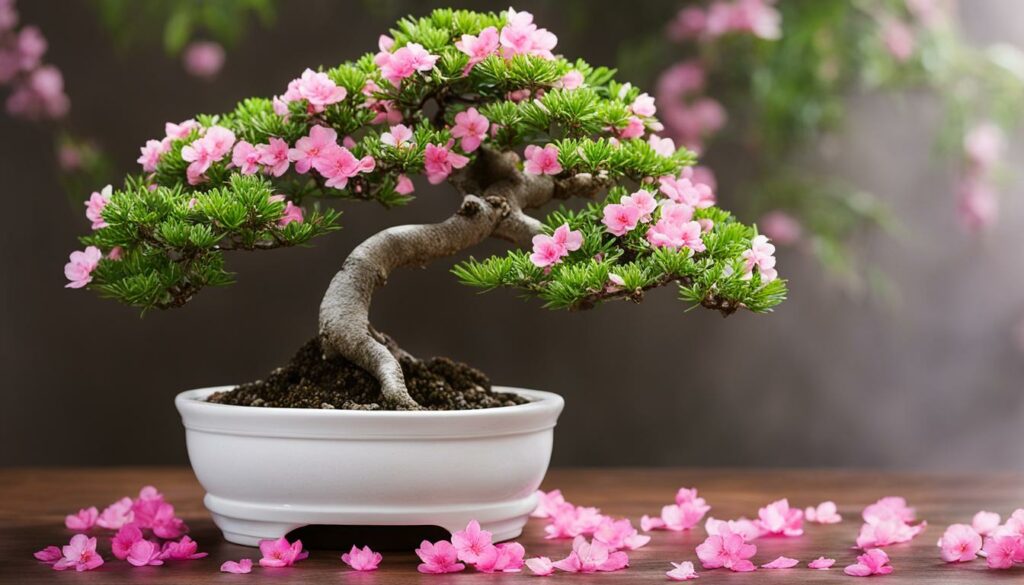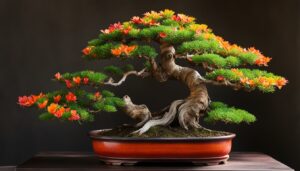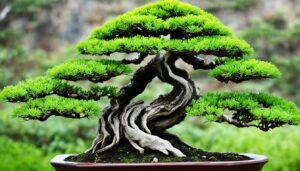If you are a bonsai enthusiast, you understand the importance of maintaining a healthy and visually appealing tree. Seasonal styling is an essential part of achieving this goal. By making strategic adjustments throughout the year, you can promote growth, prevent disease, and create stunning designs unique to each season. In this article, we will explore the strategies, techniques, and considerations involved in seasonal bonsai styling.
Key Takeaways:
- Seasonal styling is crucial to maintaining a healthy and visually appealing bonsai tree.
- Understanding bonsai growth patterns is key in making wise seasonal adjustments.
- Spring, summer, fall, and winter each offer unique styling opportunities and challenges.
- Yearly planning and adjusting techniques based on bonsai species are essential for long-term success.
- Fertilizing, watering, pest management, and disease prevention are crucial for optimal bonsai health.
Understanding Bonsai Growth Patterns
As a bonsai enthusiast, it is crucial to understand the growth patterns of your trees. Bonsais can be bred from various species, each with their own unique growth patterns that you should familiarize yourself with to ensure healthy, seasonal styling.
Bonsai trees go through different stages throughout the year, and seasonally adjusting your styling techniques helps maintain a healthy and aesthetically pleasing appearance. Understanding these patterns can guide your yearly planning, and help in preparing for the next stages of tree growth and development.
In the spring, trees tend to experience more significant growth. This phase is ideal for rejuvenating your tree after its dormancy period and encouraging new growth. Summer is when the growth decreases, and it’s crucial to focus on maintaining optimal health and managing pests. Fall is characterized by preparing for the winter dormancy period, pushing for strong root growth, and promoting tack-sharp foliage appearance. Finally, winter is when trees experience the least amount of growth, and it’s important to protect them from low temperatures, snow, and frost.
Yearly, the planning of bonsai styling with these patterns in mind is essential to maintain the beauty of your trees and optimizing them to their appropriate seasonal conditions.
Spring Styling Tips for Bonsai
Spring is a crucial time for bonsai styling, as it is the season when new growth begins and the tree recovers from dormancy. To ensure your bonsai thrives during this period, consider implementing the following tips:
1. Prune for New Growth
Spring is the ideal time for pruning your bonsai since it promotes new growth. Use a sharp and clean pair of pruning shears to carefully trim any dead, damaged, or overgrown branches. When pruning, cut back to a healthy bud or leaf to encourage new shoots to develop.
2. Repot with Fresh Soil
Spring is also an excellent time to repot your bonsai. Before doing so, remove any dead or old soil and replace it with fresh, well-draining soil. Additionally, consider trimming back some of the roots to promote new growth and encourage the tree to absorb nutrients more efficiently.
3. Water Regularly
Spring weather can be unpredictable, so it’s important to water your bonsai regularly to avoid dehydration. Monitor your tree’s soil moisture levels and adjust your watering schedule accordingly.
4. Apply Fertilizer
Fertilizer is crucial during the spring season, as it provides essential nutrients for new growth. Use a balanced fertilizer and apply it every two weeks to ensure your bonsai receives the necessary nutrients.
By following these spring styling tips, you can promote new growth, rejuvenate your tree, and set the foundation for healthy bonsai styling throughout the year.
Summer Styling Techniques for Bonsai
Summer is a crucial time for bonsai styling, as your tree’s health and appearance can be affected by high temperatures and dry conditions. To keep your bonsai thriving throughout the summer, consider the following techniques:
Pruning
Regular pruning during the summer is essential to maintain your bonsai’s shape and prevent overgrowth. Be sure to use sharp, clean tools and avoid cutting back more than one-third of its foliage at once, as this can stress the tree.
Wiring
If you’re looking to reshape your bonsai during the summer, wiring may be necessary to achieve the desired form. However, be sure to check the wires regularly to ensure they are not strangling the tree and remove them before they begin leaving marks.
“Summer is the perfect time to wire and shape your bonsai, as the warmer temperatures help the tree heal quicker.”
Hydration
During the hot summer months, it’s crucial to ensure your bonsai is receiving enough water to stay hydrated. Be sure to water your tree thoroughly and deeply, allowing the soil to fully absorb the moisture. Consider adding a layer of mulch to help the soil retain moisture and reduce evaporation.
Protect from Sun Damage
The intense summer sun can cause damage to your bonsai, especially if it is placed in direct sunlight for extended periods. Consider placing your tree in partial shade or utilizing shade cloth to protect it from excessive sunlight exposure
By following these tips, you can keep your bonsai healthy and aesthetically pleasing throughout the summer. Remember to monitor your tree’s condition regularly and make necessary adjustments based on its specific needs.
Fall Styling Strategies for Bonsai
The fall season is a crucial period for bonsai trees. As the weather turns colder, your tree’s growth rate slows down, and it prepares to enter a dormant period. To promote healthy root growth and ensure your bonsai tree thrives through the winter months, it’s crucial to adopt the right fall styling strategies.
The first step in fall styling is to remove any dead or dying leaves, branches, or flowers. These can turn into a breeding ground for pests, which can damage the tree’s roots and cause wilted foliage. Clearing out debris also helps light penetrate to lower branches, promoting growth and a healthy, full appearance.
To encourage strong root growth, it’s essential to repot your bonsai tree in the early fall. This is because your tree will grow its best roots in the fall and winter months. Repotting during this period will help your bonsai tree to maximize its growth potential, and the added nutrients will encourage healthy and robust roots. Be sure to use the right soil mixture for your bonsai tree species, as this can significantly impact its growth rate.
Another important factor to consider during the fall season is watering. As your bonsai tree enters its dormant period, it requires less water. Overwatering can lead to root rot, which can cause damage or death to your tree. As such, you should adjust your watering schedule accordingly.
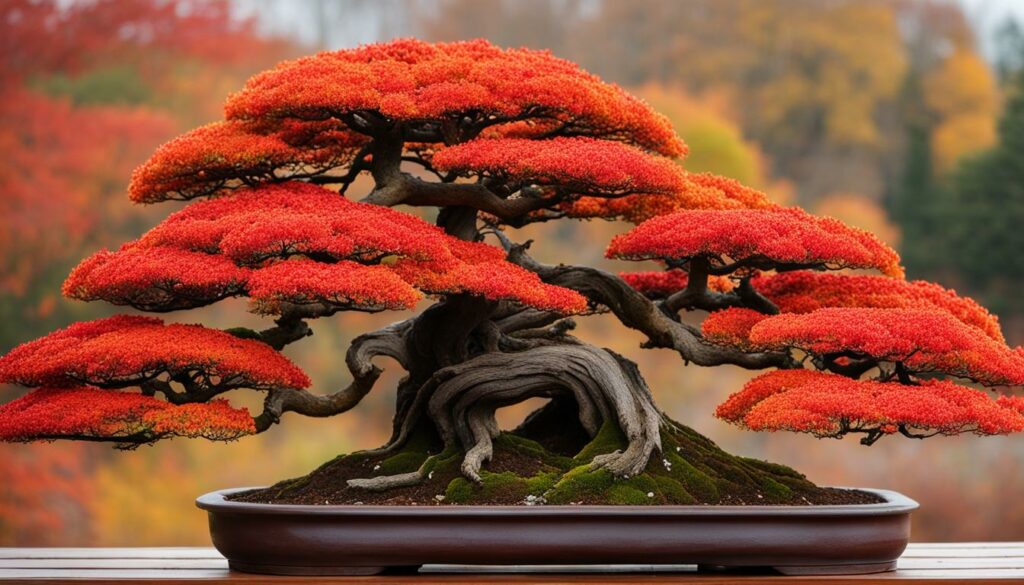
Finally, this is a perfect time to assess the overall shape and design of your bonsai tree and make any necessary changes according to the species. If you’re unsure where to start, consider seeking out advice from an expert or online communities on bonsai styling.
By adopting the right fall styling strategies, you can ensure that your bonsai tree thrives throughout the winter months and comes back stronger than ever in the spring.
Winter Care Tips for Bonsai
During the winter, it’s important to adjust your bonsai tree’s care routine to protect it from freezing temperatures and ensure it stays healthy until spring. Here are some winter care tips for your bonsai:
Protect from freezing temperatures
Bonsai trees are sensitive to cold temperatures and can die if exposed to freezing conditions for too long. To prevent this, move your bonsai to a sheltered area, such as a garage or shed, or wrap it with burlap or other protective coverings. Be sure to remove the covering during the day to allow light and air to reach the plant.
Reduce watering
During the winter, bonsai trees go into dormancy and their growth slows down. As a result, they require less water than during the growing season. Reduce watering to once a week or when the soil feels dry to the touch. Avoid getting water on the leaves or trunk of the tree as this can cause snow or ice to stick and damage the tree.
Minimize fertilization
Just like with watering, bonsai trees require less fertilizer during the winter months. Minimize the frequency and amount of fertilization to prevent overfeeding and root burn. Resume a regular fertilization routine in the spring as the tree returns to its growth period.
Provide adequate lighting
While bonsai trees may be dormant during the winter, they still require adequate light to maintain their health. If your bonsai tree is indoors, make sure it’s placed in a well-lit area, such as near a south-facing window. If your bonsai tree is outside, ensure that it’s not shaded by trees or buildings that would block the winter sun.
Note: Keeping your bonsai tree healthy through the winter months can lead to stronger growth in the spring and ultimately better aesthetic results.
Yearly Planning for Bonsai Styling
Proper yearly planning is critical for maintaining the health and aesthetic appeal of your bonsai tree. By having a plan in place, you can ensure that your bonsai receives the care it needs throughout the year, including the appropriate seasonal adjustments and styling techniques.
To create a yearly plan for your bonsai styling, start by considering the current state of your tree and identifying any necessary changes or adjustments. Take note of any upcoming seasonal transitions and plan specific styling techniques accordingly. Keep in mind that certain species of bonsai may require more or less attention depending on their growth patterns and natural tendencies.
Consider using a calendar or journal to track your yearly planning and bonsai care routine. This can help you stay organized and ensure that you remain consistent in your care efforts. Don’t forget to revisit your plan periodically throughout the year to make any necessary updates or adjustments.
Remember, having a solid yearly plan in place can help you achieve the long-term goals you have for your bonsai tree and maintain its beauty and health.
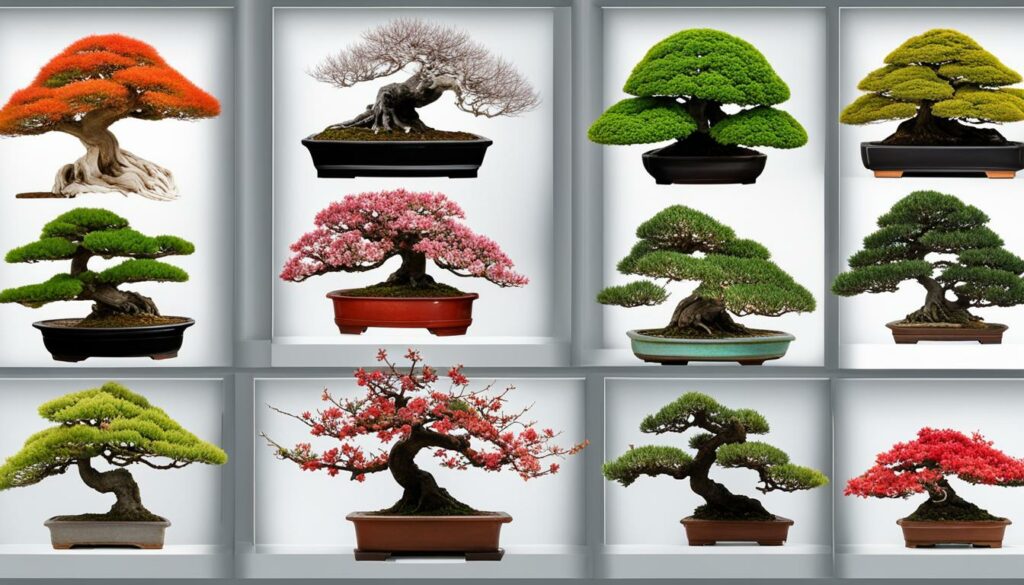
Adjusting Styling Techniques for Different Bonsai Species
When it comes to styling techniques for bonsai trees, it’s important to keep in mind that different species may require different approaches to achieve the desired aesthetic result. Understanding the unique characteristics and growth patterns of your bonsai tree can help guide your decisions in tailoring your styling techniques.
For example, a juniper bonsai may require more frequent pruning and wiring to maintain its intricate and delicate foliage. On the other hand, a maple bonsai may benefit from more gradual shaping and training techniques to achieve its signature trunk and leaf formations.
Consider the season as well when styling your bonsai tree. Certain species may respond better to seasonal adjustments, such as repotting, pruning, and wiring during specific times of the year to ensure their health and vitality.
When in doubt, do your research on the specific bonsai species you are working with and consult with experienced bonsai growers. With careful attention and consideration to, you can achieve stunning and unique styling results for any bonsai tree.
Tips for Pruning and Wiring Bonsai Trees
Pruning and wiring are essential techniques for shaping and styling bonsai trees. However, improper execution can harm your tree’s growth and development. Here are some essential tips and techniques to ensure successful pruning and wiring:
Pruning Tips
Regular pruning is essential for maintaining the desired shape and size of your bonsai tree. Here are some tips to keep in mind:
- Prune in the spring or early summer to promote new growth.
- Use sharp, clean scissors or shears to make precise cuts.
- Remove branches that cross or grow in undesirable directions.
- Ensure proper healing of wounds by applying cut paste or sealant.
- Do not remove more than a third of the leaves and branches at one time.
Wiring Techniques
Wiring is used to shape and direct the growth of branches for proper styling. The wire should be wrapped tightly around the branch but not too tight to avoid damaging the bark. Here are some tips for wiring:
- Choose the right gauge of wire, thicker for larger branches and thinner for smaller ones.
- Wrap the wire at a 45-degree angle around the branch and twist the ends tightly.
- Leave the wire in place for 6-12 months depending on the species and growth rate of the tree.
- Remove the wire carefully after it has served its purpose to avoid damaging the bark.
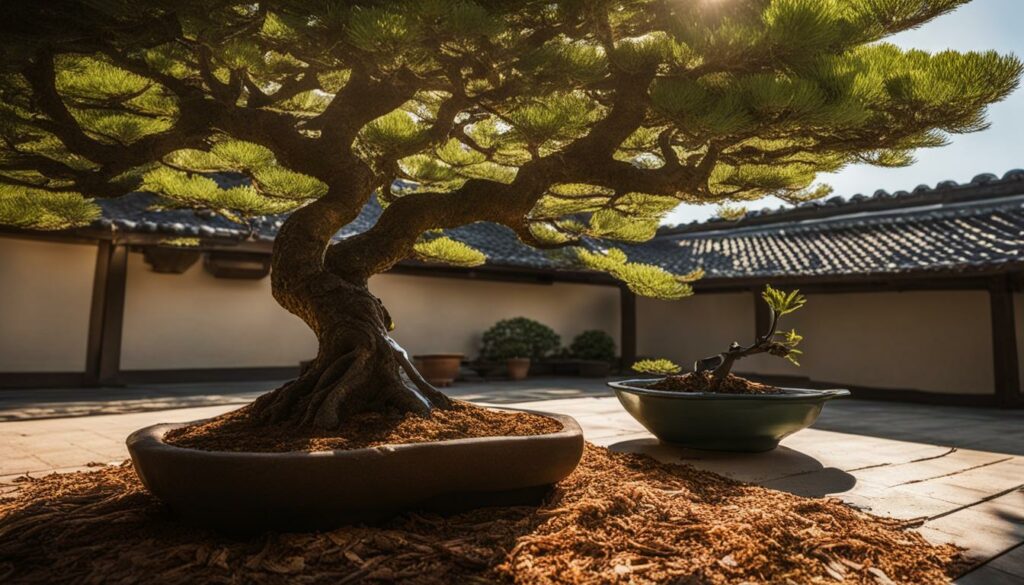
Remember that pruning and wiring techniques may vary depending on the species of your bonsai tree. Take the time to research and learn the specific requirements and techniques for your tree to achieve your desired styling results. With precision and care, pruning and wiring can greatly enhance the beauty and health of your bonsai tree.
Using Defoliation Techniques on Bonsai
Defoliation refers to the practice of removing leaves from a bonsai tree. While it may seem counterintuitive, defoliation can be a powerful technique for shaping the tree’s growth and promoting back-budding.
Defoliation is typically performed in early summer when new growth has reached its full size. Before defoliating, ensure your bonsai is healthy and in good condition. Select a few branches to defoliate, and carefully remove all the leaves, leaving only the leaf stem.
This technique will direct the tree’s energy to the remaining foliage, resulting in smaller leaves and stronger buds. It also helps to create balance and proportion in the overall design of the tree.
It is important to note that defoliation should only be done by experienced bonsai enthusiasts as it can be risky and may harm the tree if done incorrectly. Consider seeking guidance from a bonsai expert before attempting defoliation on your own.
Considerations for Successful Defoliation
- Timing: Defoliation should only be done during the growing season, and never during the tree’s dormancy period.
- Health: Ensure that your bonsai tree is healthy and in good condition before attempting defoliation.
- Branch Selection: Choose a few branches to defoliate, and avoid defoliating the entire tree at once.
- Precision: Carefully remove all the leaves, leaving only the leaf stem, to avoid damaging the remaining foliage.
- Aftercare: Provide your bonsai tree with proper aftercare, including regular watering and fertilization, to promote healthy new growth.
Defoliation can be an effective way to shape and style your bonsai tree, but it should be approached with caution and precision. Consider consulting with a bonsai expert before attempting this technique on your own.
Wiring Techniques for Bonsai Styling
Bonsai wiring is a delicate process that allows you to shape your tree’s branches into the desired position. There are several wiring techniques to choose from, and the right one depends on the thickness and flexibility of the branches you are working with.
For thicker branches, use guy wires or raffia to protect the bark from cracking. Before wiring, prune the branch to the desired length, leaving enough foliage to maintain the tree’s health. Start at the base of the branch and wrap the wire in a spiral around it, using a gentle but firm grip to avoid damaging the bark. Once you reach the tip of the branch, twist the wire, securing it in place.
For more flexible branches, use the clip-and-grow method. Attach a clip to the branch, positioning it just above a pair of leaves. Then, bend the branch to the desired angle. Over time, the branch will slowly grow in the new shape.
Remember to remove the wire after a few months to prevent it from digging into the bark and causing damage. Check your tree regularly and adjust the wiring as needed to ensure that it is growing in the desired shape.
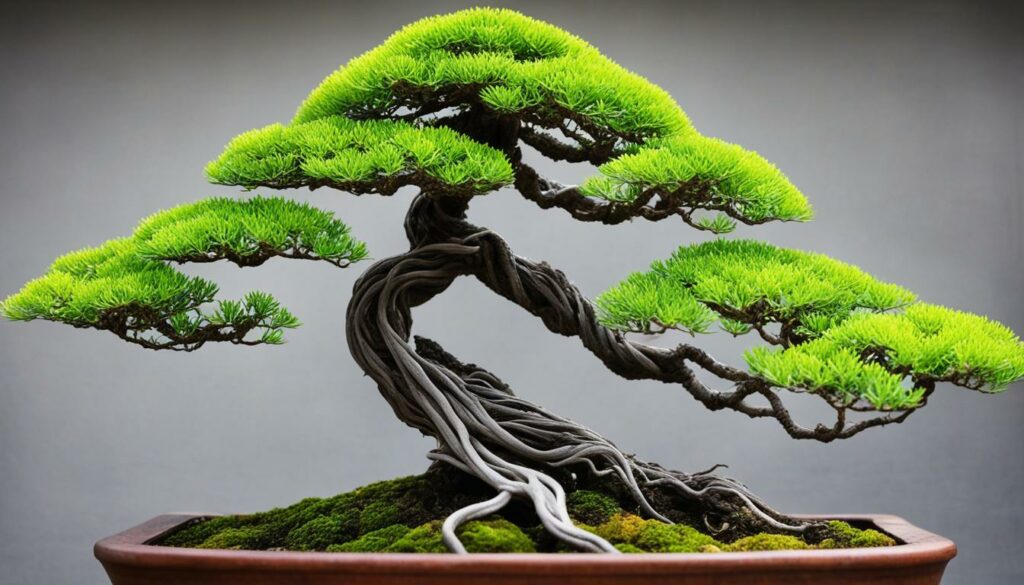 Pro Tip: To achieve natural-looking movement, vary the spacing between the wire coils and reposition the wire regularly to avoid marks on the bark.
Pro Tip: To achieve natural-looking movement, vary the spacing between the wire coils and reposition the wire regularly to avoid marks on the bark.
Techniques for Shaping Bonsai Trees
Shaping techniques are a crucial aspect of bonsai styling that creates unique forms and gives your tree a visually appealing appearance. Several shaping techniques, including carving and bending, help to transform your bonsai trees over time. While shaping your bonsai, it’s crucial to keep in mind the overall desired result and the tree’s species.
One common shaping technique for bonsai is wiring. It involves wrapping the branches and trunk of the tree with wire and gently bending them into the desired shape. It is a delicate process that requires precision and patience but yields positive results. Bonsai wire, available in various sizes, is used to wrap the branches tightly, and the branch is gently shaped to achieve the desired curve or bend. The wire is removed after a period, usually a few months, to prevent it from cutting into the bark.
Another shaping technique for bonsai is carving. Carving creates unique tree shapes and adds character and depth to your bonsai. To do this, a sharp carving knife or similar tool is used to remove wood from the trunk, branches, or roots. Afterward, the tree is treated with a wound sealant to prevent fungal infection and promote healing.
Bending is yet another shaping technique used for bonsai styling. It involves using weights, clamps, or even simple wrap techniques to curvature the trunk, creating significant appeal and intrigue. When using bending techniques, you should pay close attention to the stress placed on the tree. If the tension is excessive, it can cause damage to the tree.
Ultimately, the technique you use to shape your tree depends on several factors, including the species of the tree, the desired shape and style of the bonsai, and the current growth stage. By understanding the differences in each technique, you can create visually stunning and unique bonsai designs.
Repotting Tips for Seasonal Styling
Repotting is an essential part of seasonal styling for bonsai trees. It promotes healthy root growth and ensures that your tree has sufficient nutrients for optimal growth. Here are some repotting tips:
- Timing: Repot your bonsai tree during the period of active growth, usually in early spring. This ensures that your tree can recover from the repotting process more quickly.
- Technique: Gently remove the tree from its current container, taking care not to damage the roots. Trim away any dead or damaged roots, taking care not to remove too much. Place the tree into a new container filled with fresh bonsai soil, and gently pack it around the roots.
- Bonsai Repotting Mix: Use a specialty bonsai repotting mix to ensure that your tree has the right balance of nutrients and drainage. A good mix will contain materials like sand, peat moss, perlite, and bark.
- Watering: After repotting, give your bonsai tree a thorough watering to settle the soil and reduce air pockets around the roots. But don’t overwater; allow the soil to dry slightly between waterings.
Remember to be patient after repotting your bonsai tree. It may take a few weeks for the tree to adjust to its new container and start showing signs of new growth. But once it does, you’ll notice a fresh burst of energy and health in your tree.
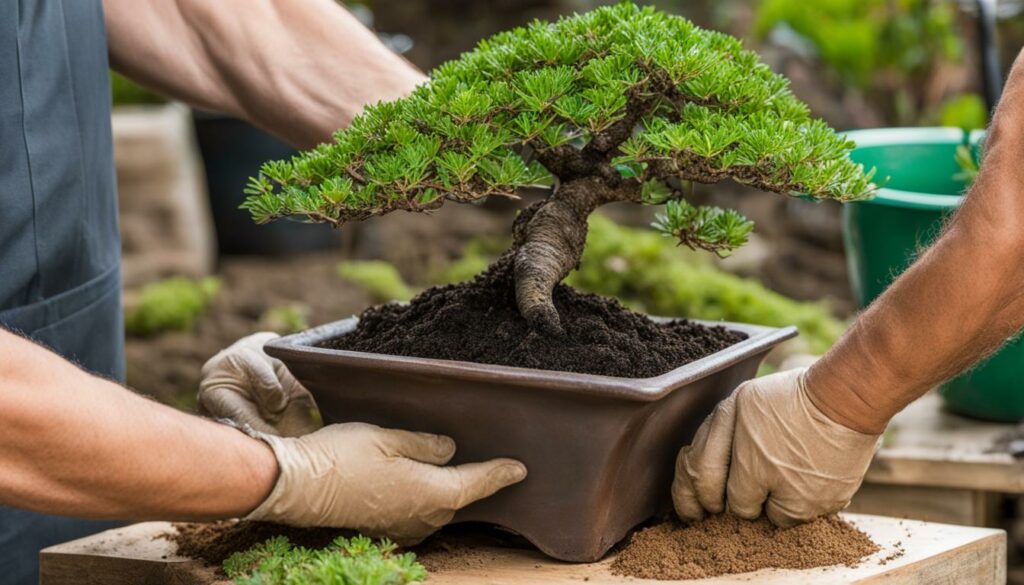
Fertilizing and Watering Guidelines for Bonsai Styling
Proper fertilizing and watering are crucial for maintaining the health and beauty of your bonsai tree.
Fertilizing Guidelines:
Use a balanced fertilizer with equal parts nitrogen, phosphorus, and potassium (10-10-10 or 20-20-20) to ensure your bonsai tree gets the necessary nutrients. Apply the fertilizer every two weeks during the growing season (spring and summer) and reduce to once a month during the dormant season (fall and winter).
Watering Tips:
Water your bonsai tree thoroughly until the water drips out of the drainage holes in the pot. Allow the soil to dry partially before watering again. The frequency of watering depends on factors such as pot size, climate, and species of bonsai tree. Avoid overwatering, as this can cause root rot and other diseases.
Hydration Insights:
Bonsai trees prefer a well-draining soil mix that retains moisture but allows excess water to drain freely. Check the moisture level of the soil regularly by sticking a chopstick or moisture meter into the soil. Increase watering during hot and dry weather.
Bonsai Tree Watering Table
| Bonsai Species | Watering Frequency | Sunlight Requirements |
|---|---|---|
| Juniper Bonsai | Every 2-3 days | Full sun |
| Chinese Elm Bonsai | Every 4-5 days | Partial shade |
| Japanese Black Pine Bonsai | Every 5-7 days | Full sun |
| Ficus Bonsai | Every 5-7 days | Bright, indirect light |
Remember to adjust watering frequency based on your specific bonsai tree and growing conditions. By following these fertilizing and watering guidelines, you can ensure your bonsai tree has everything it needs to thrive and showcase its natural beauty.
Pest and Disease Management for Bonsai
Your bonsai tree is susceptible to various pests and diseases that can damage its health and hamper its growth. It is essential to have effective strategies in place to manage these issues and prevent them from recurring.
Common pests that can infest bonsai trees:
| Pest | Symptoms | Treatment |
|---|---|---|
| Spider mites | Yellowing leaves, fine webbing | Prune and isolate affected areas, spray with water and insecticidal soap |
| Scale insects | Brown or yellow spots on leaves, sticky residue | Remove and destroy affected leaves and branches, spray with horticultural oil |
| Mealybugs | White, cotton-like substance on leaves and stems | Prune and isolate affected areas, spray with rubbing alcohol |
Common diseases that can affect bonsai trees:
| Disease | Symptoms | Treatment |
|---|---|---|
| Root rot | Yellowing leaves, wilting, root decay | Remove damaged roots, repot in fresh soil, apply anti-fungal treatment |
| Powdery mildew | White or grey powdery substance on leaves | Remove infected leaves, spray with a fungicide and increase ventilation |
| Black spot | Black spots on leaves, yellowing, and premature leaf drop | Remove infected leaves and destroy, apply fungicide consistently |
Prevention is the key to avoiding these issues. Regularly inspect your bonsai tree for any signs of pests or disease and take immediate action to address them. Proper bonsai health maintenance, including consistent fertilizing, watering, and pruning, can also help prevent pest and disease problems. Natural and organic pest control options can be used when feasible, reducing chemical use and promoting a healthier ecosystem for your bonsai.
Conclusion
Congratulations! You have completed the journey to becoming a seasoned bonsai tree styler. By understanding the growth patterns and needs of your bonsai tree, you can make informed decisions on the best seasonal styling strategies to implement. With the techniques and tips outlined in this article, you are well-equipped to create stunning visual designs that promote the health and longevity of your bonsai tree.
Remember, yearly planning is essential for achieving optimal results. By setting goals and creating a schedule, you can ensure that you are giving your bonsai tree the care it needs throughout the year. Whether you are pruning, wiring, shaping, or repotting, always prioritize precision and care.
Fertilizing and watering are also crucial aspects of maintaining the health of your bonsai tree. By following the guidelines outlined in this article, you can keep your tree properly hydrated and nourished.
Finally, remember to be vigilant with pest and disease management. By staying proactive and utilizing organic pest-control options whenever possible, you can ensure the continued health of your bonsai tree.
Thank you for taking the time to read this article on seasonal styling strategies for bonsai. We hope that you have found it informative and helpful in your journey as a bonsai tree styler.
FAQ
Why is seasonal styling important for bonsai trees?
Seasonal styling is essential for bonsai trees because it allows you to make adjustments throughout the year to promote health, encourage growth, and achieve the desired aesthetic appeal. Different seasons offer unique opportunities for pruning, wiring, and shaping, ensuring that your bonsai looks its best year-round.
How do I understand bonsai growth patterns?
Understanding bonsai growth patterns requires observing and familiarizing yourself with how your specific tree species grows and responds to different seasons. By carefully observing the timing and direction of growth, as well as the dormancy period, you can make informed decisions about the best time to style and care for your bonsai.
What are some spring styling tips for bonsai?
In spring, you can focus on rejuvenating your bonsai after winter dormancy. Pruning back branches to allow new growth, wiring for desired shape, and repotting to replenish soil nutrients are all effective techniques for spring styling. Ensure proper watering and sunlight to support healthy growth during this season.
What are some summer styling techniques for bonsai?
Summer is a period of vigorous growth for bonsai trees. Pruning for refinement, wiring to enhance movement, and defoliation for better branch structure are key techniques during this season. It is also crucial to provide sufficient water, shade, and protection from extreme heat to maintain tree health.
What are some fall styling strategies for bonsai?
Fall is a critical time to prepare your bonsai for the upcoming winter dormancy period. Focusing on root development through repotting, reducing excessive foliar growth, and applying organic fertilizers are essential fall styling strategies. This season also offers opportunities for refining branch structure and promoting autumn colors in certain tree species.
How do I care for my bonsai during the winter?
Winter care for bonsai involves protecting the tree from freezing temperatures and ensuring adequate hydration. This includes placing the tree in a sheltered location, insulating the pot, and avoiding excessive watering. Maintain a proper watering schedule by checking the soil’s moisture level and adjust it as needed.
Why is yearly planning important for bonsai styling?
Yearly planning allows you to create a roadmap for your bonsai’s growth and styling. It helps you set specific goals, determine the timing for various techniques, and track the progress of your tree’s development. Through yearly planning, you can ensure the long-term health and aesthetics of your bonsai.
Do different bonsai species require different styling techniques?
Yes, different bonsai species may require unique styling techniques to achieve their optimal appearance. Some species have specific growth habits, leaf shapes, or natural characteristics that need to be considered when applying styling techniques. It’s crucial to research and understand the specific needs of your bonsai species before styling.
What are some essential pruning and wiring tips for bonsai trees?
When pruning your bonsai, it’s important to use clean and sharp tools, make precise cuts at a proper angle, and remove dead or weak branches. For wiring, select appropriate wire sizes, apply them gently but firmly along the desired path, and avoid putting excessive pressure on branches to prevent damage.
When should I consider using defoliation techniques on my bonsai?
Defoliation techniques are typically employed in certain situations, such as encouraging back-budding, improving ramification, or reducing leaf size. It is generally done during the tree’s growth season, but specifics vary by species. Consult bonsai literature or seek guidance from experienced bonsai enthusiasts to determine the best times and methods for defoliation in your specific species.
How can I effectively wire bonsai trees for styling?
To wire bonsai trees, start with an anchor wire and wrap it around the trunk or branch base. Then, use additional wires to guide and shape the branches. Gently bend the wired branches into the desired positions while taking care not to damage them. Maintaining an appropriate tension and regularly monitoring the wired areas are vital for successful wiring.
What are some techniques for shaping bonsai trees?
Shaping bonsai trees involves various techniques such as carving, bending branches, using guy wires, and clip-and-grow methods. Carving can create hollows, jins, or deadwood effects. Bending branches with gradually increasing pressure over time helps achieve specific shapes. Guy wires are useful for shaping thick branches. The clip-and-grow method involves pruning and allowing new growth to shape the tree over time.
What are some important considerations when repotting bonsai trees for seasonal styling?
When repotting bonsai, some key considerations include selecting an appropriate pot size, timing it before the growing season to minimize stress on the tree, using well-draining soil mixes, and ensuring proper aftercare. Repotting can help improve root health, promote new growth, and maintain the overall well-being of your bonsai.
How should I fertilize and water my bonsai tree for optimal styling results?
Fertilizing bonsai trees requires using balanced and slow-release fertilizers during the growing season. Follow product instructions and avoid overfertilizing, which can cause root burns. Watering frequency depends on factors such as species, pot size, and climate. Water deeply, ensuring the entire root ball is moistened, and allow for proper drainage to prevent waterlogging.
How can I manage pests and prevent diseases in my bonsai trees?
Effective pest and disease management for bonsai trees involves maintaining good cultural practices, such as regular inspection, proper watering, and keeping the tree in optimal health. Encourage beneficial insects, practice good hygiene, and promptly address any signs of pests or diseases. Organic pest control methods, such as neem oil or insecticidal soap, can be used if necessary.
